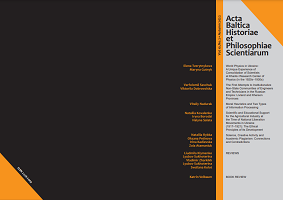World Physics in Ukraine: A Unique Experience of Consolidation of Scientists at Kharkiv Research Center of Physics (in the 1920s–1930s)
World Physics in Ukraine: A Unique Experience of Consolidation of Scientists at Kharkiv Research Center of Physics (in the 1920s–1930s)
Author(s): Elena Tverytnykova, Maryna GutnykSubject(s): Epistemology, History of ideas, Philosophy of Science, State/Government and Education, Sociology of Education
Published by: Tallinna Tehnikaülikooli õiguse instituut
Keywords: atomic nucleus fission; international cooperation; nuclear physics; science of Ukraine; scientific consolidation; theoretical physics; Ukrainian Institute of Physics and Technology;
Summary/Abstract: The article examines the development of physics research in Ukraine on the example of the Ukrainian Institute of Physics and Technology (UIPT). Founded on the initiative of the eminent physicist Abram Ioffe, the UIPT has gradually become one of the world’s leading research institutions. During 1928–1938, many important events took place at the institute, which became markers for the development of physics in Ukraine and the USSR as well as in the world. An experiment on the fission of atomic nucleus using artificially accelerated protons confirmed the validity of the intentions to reorient research towards nuclear physics. The involvement of foreign specialists in the work of the UIPT contributed to the informal consolidation of scientific thinking in physics. Outstanding physicists of the world such as Boris Podolskyi, Oleksandr Weisberg, Konrad Weiselberg, Friedrich Houtermans, Laszlo Tisza, Fritz Lange, Victor Weisskopf, George Placzek, Paul Dirac, Georgii Gamov, Niels Bohr, Paul Ehrenfest, and others worked here for longer or shorter periods. Niels Bohr, Ivar Waller, Milton S. Plesset, Evan J. Williams, and Leon Rosenfeld made reports at the theoretical conferences of UIPT. As a result, in the late 1920s and during the 1930s, an informal society of physicists from around the world was formed in Kharkiv. The consolidation of talented scientists has accumulated traditions, centuries of experience, and practical knowledge in the field from many scientific schools around the world.
Journal: Acta Baltica Historiae et Philosophiae Scientiarum
- Issue Year: 10/2022
- Issue No: 2
- Page Range: 5-23
- Page Count: 19
- Language: English

